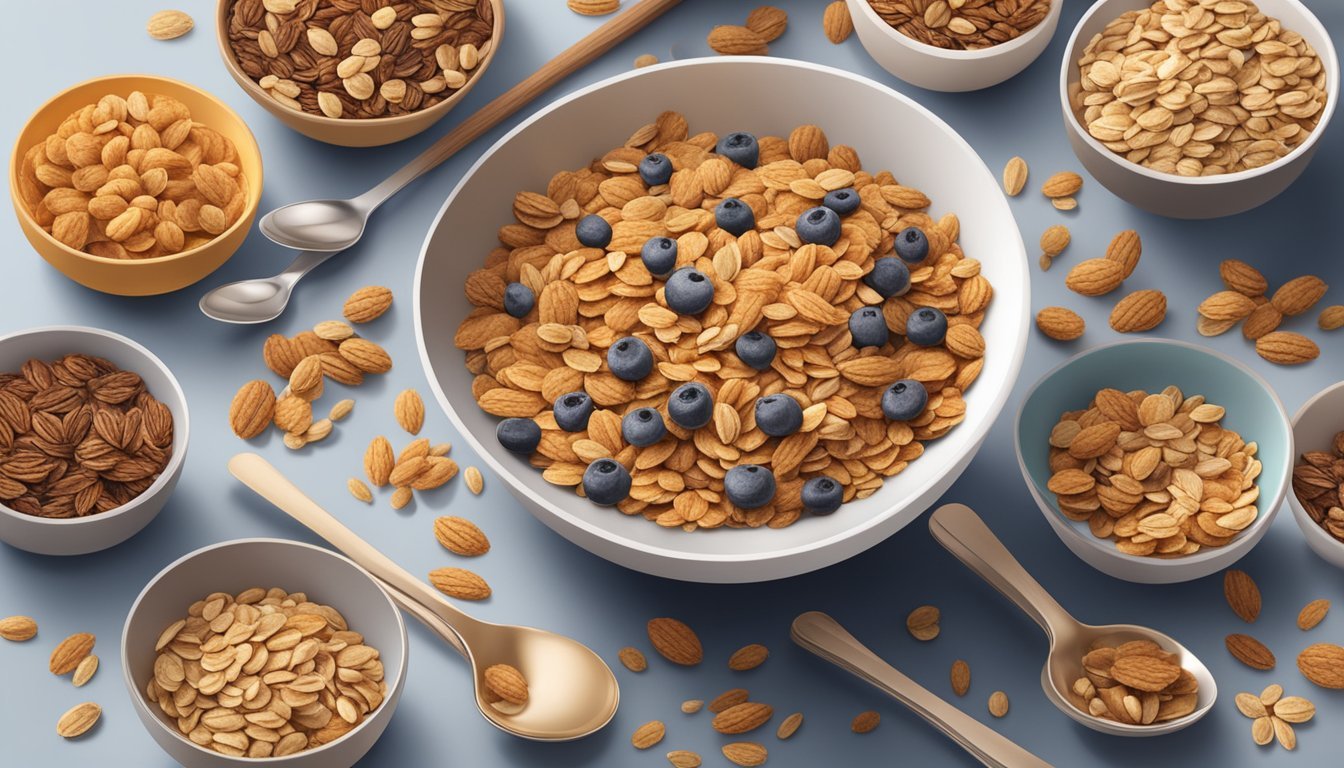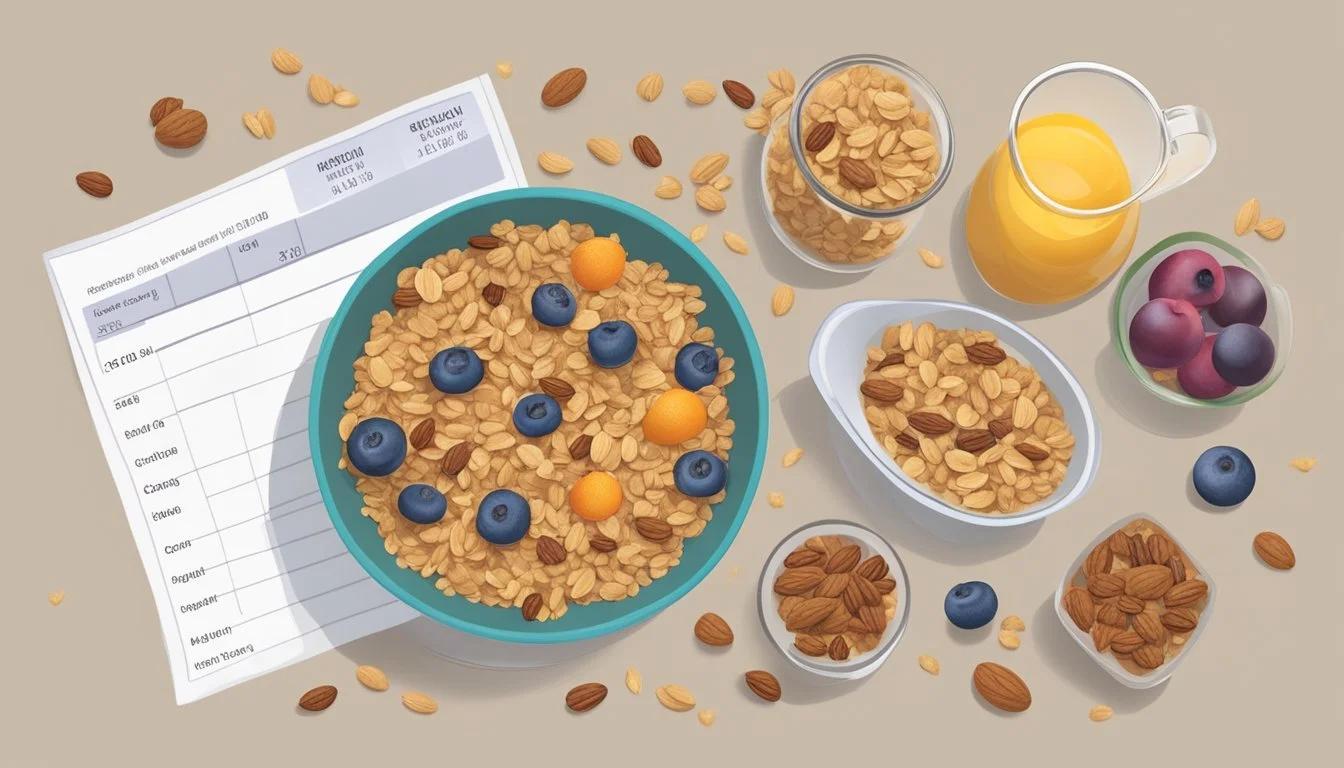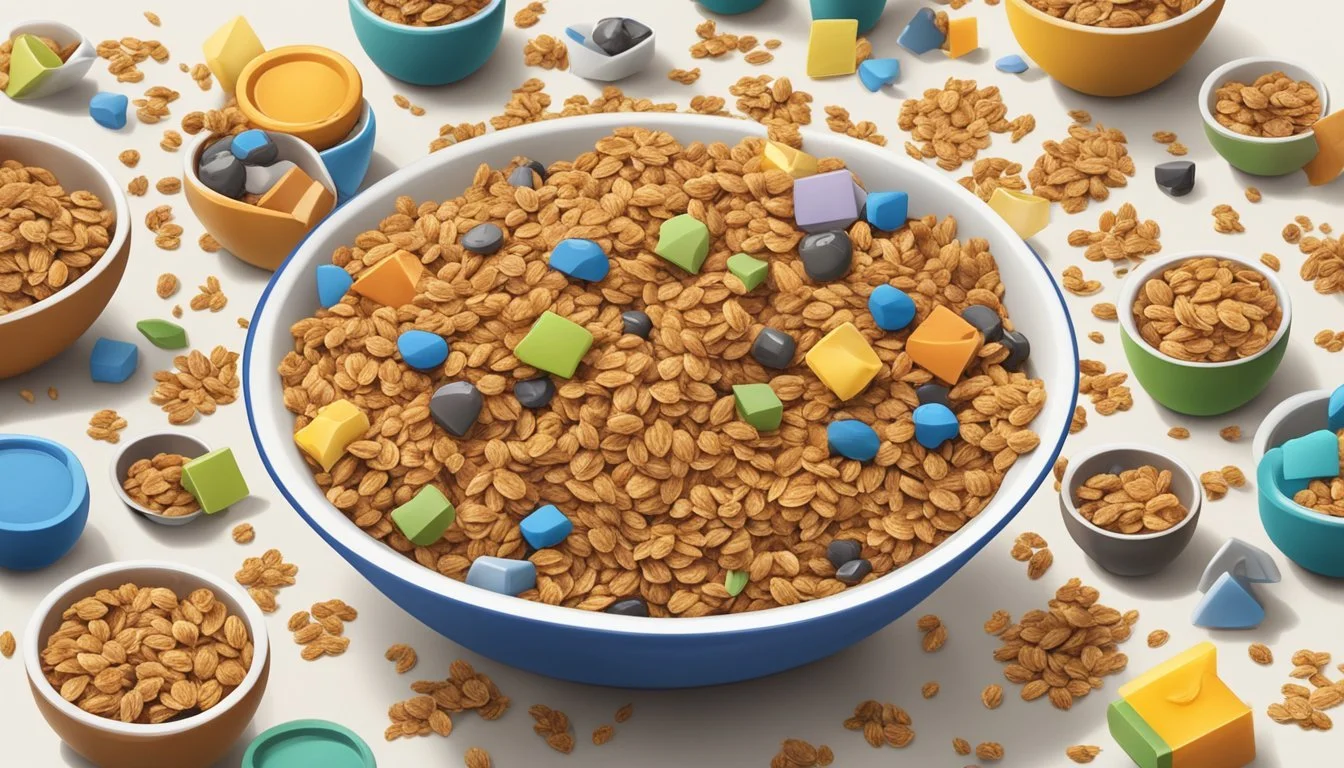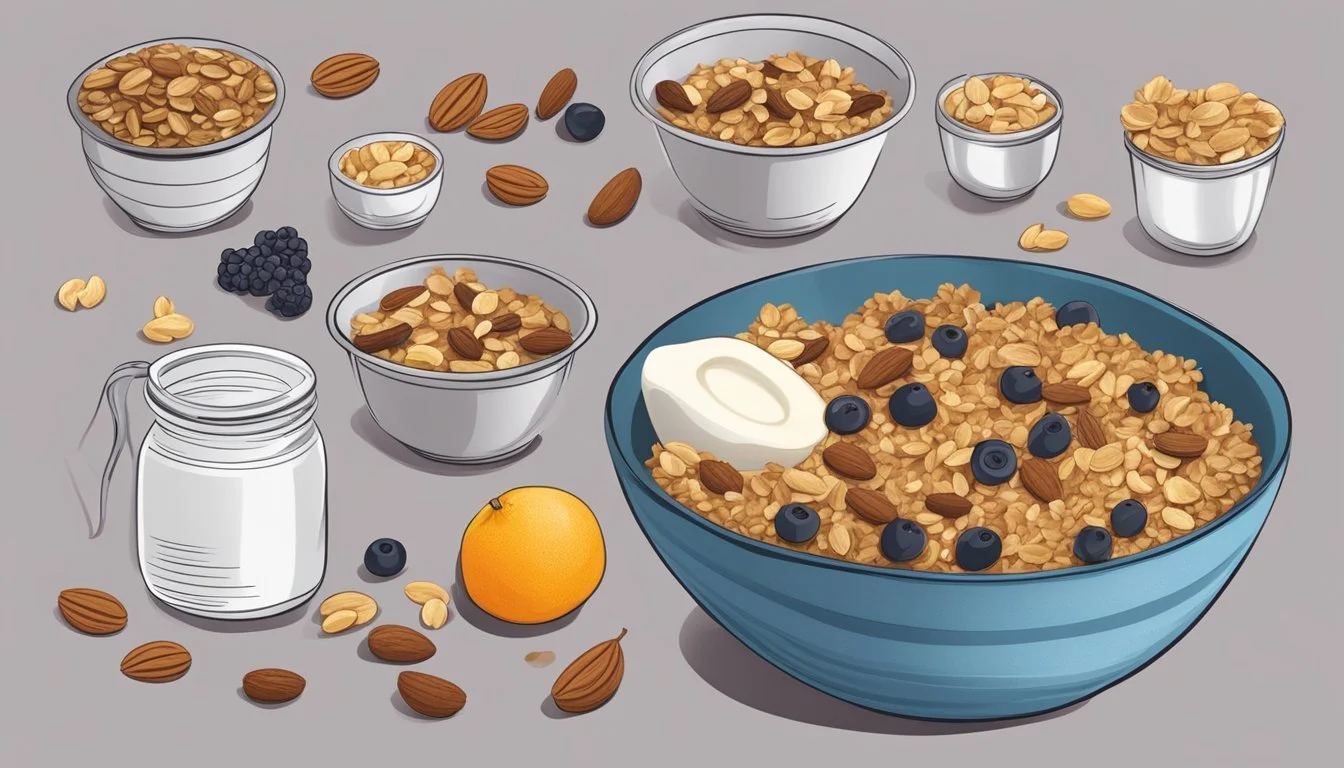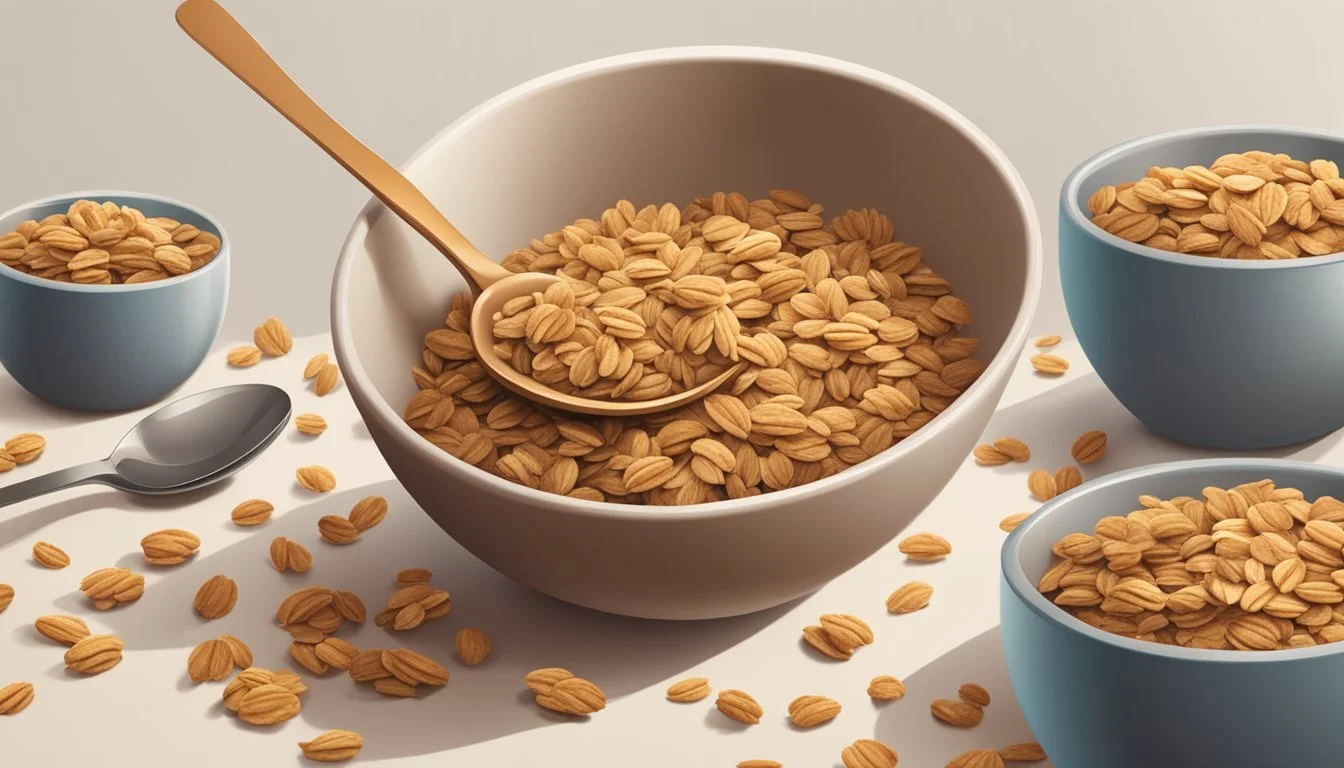How Many Servings of Granola Per Day Is Too Much?
Understanding Your Limits
Granola is often lauded as a healthy, wholesome food, touted for its mix of oats, nuts, seeds, and sometimes dried fruit. Rich in nutrients and fiber, it can be a nutritious addition to meals, especially breakfast. However, with the variety of granola brands and recipes available, the nutritional content can vary significantly. A closer look at granola's benefits needs to consider its calorie, sugar, and fat content which can quickly transform it from a health food to a calorie-dense treat.
Serving size is crucial when incorporating granola into a balanced diet. The typical serving size for granola is around 1/2 cup, but this can fluctuate depending on the brand and the ingredients used. An average granola serving may contain about 200-300 calories with variations in fat and sugar content. Overconsumption of granola can lead to an excessive intake of calories and added sugars, potentially offsetting its health benefits.
Nutrient profiling is equally important as it dictates the impact of granola on daily dietary requirements. Granolas with high levels of fiber and protein can offer a satiating effect, potentially aiding in weight management when consumed in appropriate amounts. When selecting granola, individuals should aim for options that are high in fiber and protein but low in added sugars and saturated fats to harness the maximum health benefits without overindulgence.
Understanding Granola
Granola is a popular breakfast food and snack that consists of rolled oats, nuts, and sweeteners such as honey or sugar. It is often combined with dried fruit for flavor and added nutrition.
Composition of Granola
Nutrients: Each serving of granola is dense with a variety of nutrients, including:
Whole grains: Typically, granola includes whole grains like oats, which are a good source of fiber.
Protein: Nuts and seeds in granola contribute to its protein content, which is essential for body repair and growth.
Healthy fats: Nuts and seeds also provide healthy fats that are necessary for heart health.
Vitamins and minerals: Depending on the added ingredients, granola may contain iron, calcium, vitamin D, and antioxidants.
Additives:
Added sugars: Sweeteners like honey or sugar are commonly added to granola.
Dried fruit: This adds natural sweetness and fiber but can also increase the sugar content.
Consideration: It's important to check labels as some granola may have significant added sugars and fats, which can reduce its healthfulness.
Health Benefits of Granola
Fiber: The fiber from whole grains and seeds promotes healthy digestion and can help to lower cholesterol levels.
Nutrition: The inclusion of nuts and seeds provides a range of nutrients that support overall health.
Antioxidants: Ingredients such as nuts and dried fruit can provide antioxidants, which defend the body against oxidative stress.
Granola as Part of a Balanced Diet
Portion Size: Adhering to appropriate portion sizes, generally ranging from 1/4 cup to 1 full cup, is key to enjoying granola as part of a balanced diet.
Physical Activity: Given its calorie-dense nature, granola should be consumed in proportion to one's physical activity levels.
Dietary Guidelines: Ensure granola consumption aligns with the dietary guidelines for whole grains, fiber, added sugars, and overall calorie intake for maintaining health.
Tip: For a healthier choice, look for granola with higher fiber content (at least 3-5 grams per serving) and lower added sugars.
Reading Nutrition Labels
When considering granola consumption, it's important to interpret nutrition labels correctly. These labels provide vital information about serving sizes, nutritional content, and the presence of added sugars and fats, which is essential for maintaining a healthy diet.
Understanding Serving Sizes
The serving size on a food label indicates the standard amount typically consumed in one sitting, which is crucial for measuring the number of servings one eats. For granola, the serving size might be listed in cups (e.g., 2/3 cup) alongside the metric equivalent (e.g., 55 grams) and servings per container. It is important to compare the portion size one eats to the serving size listed to gauge the actual intake of calories and nutrients.
Analyzing Nutritional Content
The nutritional content section on a label lists the number of calories per serving and the breakdown of macronutrients: fats, carbohydrates (including dietary fiber and total sugars), and protein. The label also includes percentages of the daily recommended values (%DV) for these nutrients, based on a 2,000 calorie diet. For fats, it's advised to aim for higher intakes of healthy fats and lower intakes of saturated and trans fats. For granola, ingredients like nuts and seeds could provide healthy oils, unlike coconut oil, which is high in saturated fat.
Calories: Essential for monitoring energy intake.
Fat: Includes total, saturated, and trans fats.
Cholesterol: Often low in granola, but should be monitored.
Sodium: Should be kept low to maintain heart health.
Identifying Added Sugars and Fat
The ingredients list can reveal the presence of added sugars and fats in granola, which can significantly affect its healthfulness. Ingredients are listed in order of quantity, from highest to lowest. Added sugars may come in various forms, such as syrups or cane sugar, and can contribute to excessive calorie intake. One should aim for granola with no added sugars or those sweetened with natural fruit sources. Fats may include healthy options like nuts or unhealthy saturated fats like palm oil. Identifying and limiting these ingredients is key for a balanced diet.
Healthy Eating Habits
An individual's daily diet should align with a caloric intake around 2,000 calories, depending on their unique needs. Within this framework, managing the density and portions of foods, ensuring dietary variety, and integrating consistent physical activity are pivotal.
Portion Control and Moderation
A practical guide for granola intake is to aim for a serving size ranging from 2 tablespoons (12.5 grams) to 2/3 cup (67 grams). Understanding portion distortion, which is the perception of larger portions as appropriate amounts to eat at once, is essential. Individuals should be wary of the health halo effect, where granola may be perceived as healthy, and thus consumed in excessive amounts, leading to high calorie, sugar, and fat consumption.
Recommended Portion Size for Granola:
Minimum: 2 tablespoons (12.5 grams)
Maximum: 2/3 cup (67 grams)
Incorporating Variety in Your Diet
It is important to include a variety of whole foods such as vegetables, fruits, dairy, and protein foods to ensure a balanced nutrient intake. Making healthier choices by opting for low-sugar granola brands and complementing them with nutrient-dense foods can maximize the health benefits of one's diet.
Examples of Nutrient-Dense Companions to Granola:
Vegetables: Spinach, kale
Fruits: Berries, bananas
Dairy: Greek yogurt, skim milk
Protein: Nuts, seeds
The Role of Physical Activity
Physical activity complements a balanced diet and can increase caloric needs, thereby allowing for greater flexibility in portion sizes. Engaging in regular physical activity not only helps to manage weight but also enhances the overall benefits of a healthy diet.
Recommended Physical Activity:
Adults: At least 150 minutes of moderate aerobic activity or 75 minutes of vigorous activity per week, plus muscle-strengthening activities on 2 or more days per week.
Granola's Place in Daily Consumption
Granola can be a nutritious addition to one's diet when consumed in appropriate amounts. It offers beneficial nutrients but also contains calories and sugars that necessitate careful portion control.
Recommended Servings of Granola
One serving of granola is typically 1/2 cup, providing a substantial amount of nutrients such as iron, vitamin D, and protein. The Dietary Guidelines for Americans advise that the number of servings should fit within the individual's daily calorie needs, which vary based on age, gender, and physical activity. The American Heart Association suggests that women should limit their intake to 6 teaspoons (25 grams) of added sugar per day and men to 9 teaspoons (38 grams). Considering granola can contain high amounts of sugar, it’s crucial to read labels and measure servings accordingly.
Example Serving:
Calories: Approximately 200-300
Sugar: Can range from 4 to more than 15 grams
Fat: Generally 10-15 grams, with varying levels of saturated fat.
Excess Intake and Its Effects
Excessive consumption of granola risks increasing daily intake of sugar, calories, and saturated fats, which may lead to weight gain and a negative impact on LDL cholesterol levels. A high intake of added sugars is linked to an increased risk of heart disease. Moreover, overindulging can result in an imbalance of nutrients and an escalated blood sugar level, offsetting the potential benefits of this high-fiber food.
Effects of Overconsumption:
Weight gain due to high-calorie content
Potential spike in LDL cholesterol and blood sugar
Adapting Serving Sizes to Needs
Individual needs for granola servings may vary. Active individuals may require larger portion sizes to sustain energy levels, whereas those with a sedentary lifestyle might need to be more cautious. It is recommended to personalize granola intake based on one’s dietary requirements, energy expenditure, and any health considerations, like a predisposition to heart disease or blood sugar irregularities. Adjusting granola portion sizes can help maintain a balanced diet.
Personalized Serving Size Considerations:
Adjust the amount based on caloric and nutrient needs
Monitor sugar and fat content in relation to overall dietary limits
Practical Tips for Consumption
When incorporating granola into one's diet, it is essential to consider the nutritional content, serving size, and methods of consumption to maximize health benefits while avoiding overindulgence.
Selecting Healthier Granola Options
Individuals should seek out granola options that boast a high-fiber content and are made from whole grains. Labels indicating low-fat or fat-free varieties can be misleading; instead, focus on granolas with healthy fats from nuts and seeds. Look for products that have no added sugar or use natural sweeteners sparingly.
Fat Content: Choose granolas with healthy fats but are low in saturated fat.
Sugar Content: Opt for granolas labeled as having no added sugar.
Fiber and Whole Grains: Ensure the granola includes plenty of high-fiber, whole grain ingredients.
Creative Ways to Enjoy Granola
Granola's versatility allows it to be a healthy addition to various meals beyond just breakfast. Combine granola with yogurt or milk for a classic pairing, or sprinkle it over fruit for added texture. Use granola as a topping for salads to introduce a pleasant crunch.
Breakfast: Mix granola with low-fat yogurt or milk and fresh fruit.
Dessert: Sprinkle granola on fat-free or low-fat yogurt topped with fruit to create a nutritious dessert.
Snack: Handfuls of granola with high-fiber content can be a satisfying snack.
Avoiding Common Pitfalls
Portion control is crucial when enjoying granola due to its dense caloric content. Serving sizes can range from 1/4 cup to a full cup, so it is essential to stick to the recommended portion sizes to avoid consuming too many calories or excess sugar. Keep an eye out for the serving size on the nutrition label and measure it out to avoid guesswork.
Serving Size: Adhere to the granola's labeled serving size, as it varies by brand.
Portion Control: Limit intake to avoid excess calories and sugars—measure servings or use smaller bowls.
By choosing granola wisely, integrating it into a balanced diet creatively, and staying vigilant about portion sizes, one can enjoy this nutritious snack without overstepping the boundaries of moderation.
The Impact of Granola on Health
Consuming granola has diverse effects on health due to its components like whole grains, protein, and fiber. However, portion control is key, as granola can be high in calories and sugar.
Effects on Gut Health
Granola, often rich in fiber, is beneficial for gut health as it aids in digestion and helps maintain a healthy gut bacteria balance. The whole grains and oats typically present in granola contribute to this positive effect. Adequate fiber also fosters a feeling of fullness, which can assist in weight control.
Granola and Weight Management
The high fiber and protein content in granola can promote satiety, potentially aiding in weight management. However, serving sizes are critical since granola can be calorically dense. A small serving typically provides a good balance of nutrients without excessive calorie intake, but large portions could contribute to weight gain.
Granola and Cardiovascular Health
Consuming granola can support cardiovascular health due to the presence of whole grains and unsaturated fats, which may help manage cholesterol levels. However, varieties with a lot of added sugar or saturated fats can negate these benefits. Ideally, one should choose granolas with high unsaturated fats and minimal added sugars to lessen the risk of heart disease.
Conclusion
Determining the exact number of granola servings that is considered too much per day depends on individual dietary needs and the specific granola composition. However, as a general guideline, moderation is key. One should aim for granola that is low in sugars and high in fiber to amplify its health benefits.
Recommended Serving Sizes:
Adults: Typically, a serving of granola is around 1/4 cup to 1 cup (30 to 85 grams), depending on the variety and brand.
Fiber Content: Seek granola with at least 3-5 grams of fiber per serving.
Sugar Content: Opt for granola with the least amount of added sugar.
Incorporating granola into a balanced diet means choosing a portion that aligns with one's overall energy needs. For those monitoring caloric and sugar intake, it is advisable to stick to the lower end of the serving scale.
Individuals should also consider pairing granola with healthy choices like yogurt or fruit to enhance nutritional value without overindulging. They may even integrate it into their meals in lieu of other foods rather than adding it on top of their regular diet.
In summary, they should enjoy granola in moderation, considering both portion sizes and the granola's nutritional profile, to avoid exceeding dietary recommendations for sugars and calories while still obtaining the benefits of a wholesome and energizing food option.

